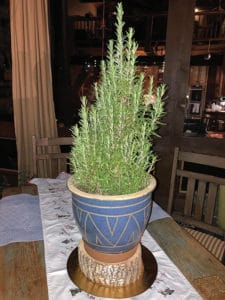By Jodi Larison, extension master gardener intern, University of Vermont
While rosemary is not a perennial in Vermont, you can still grow and enjoy fresh rosemary all year. Just plant it in a container. Bring it outside in warmer weather and inside before the first frost.
Why rosemary?
It is attractive, resembling a small pine tree, and has a pleasant scent, is easy to grow and offers great flavor and versatility as a culinary herb. All common rosemary (Rosmarinus officinalis) plants provide edible rosemary.

Rosemary, a versatile culinary herb, can be grown successfully indoors, provided that it is not over watered and gets ample light.
Rosemary can be grown from seed, though not recommended, or by rooting stem cuttings. Plants usually can be purchased for under $10 and are available at garden centers during warmer months and by mail order anytime. Make sure the plant you choose is a common rosemary plant with an upright form.
Select an appropriate container for potting your rosemary. My rosemary plant was about 7 inches tall when I bought it and is now 22 inches tall. After purchasing, I planted it in a decorative, partially glazed ceramic container 10 inches in diameter and 9 inches in height with a drainage hole at the bottom, a container it could grow into. An alternate option would be to use a smaller container and then transplant to a larger one as the plant grows.
For planting, use soil amended with compost. Drainage is important, as rosemary will not tolerate excess water, but do not let your plant dry out. If you notice that some leaves are no longer green, more water is needed.
I fertilize my plant with a food-safe, water-soluble fertilizer when it is outside. Rosemary needs sun, so place your rosemary in a spot where it will get at least 6 hours of sunlight daily.
The only pruning I have done is to clip off stems when harvesting fresh rosemary for cooking or to remove dead stems. If you choose, you can prune your plant to shape it.
While rosemary is an herb that can be used to flavor many foods, I use it mostly in cooking chicken and potatoes. I keep things simple, using only three ingredients and minimizing clean-up by using one dish for prep and cooking.
Rosemary chicken: To prepare the chicken, use skinless boneless breasts or thighs. Remove visible fat, place in a single layer in an oven-safe glass baking dish, then add balsamic vinegar and fresh chopped rosemary leaves. Turn the chicken so it is fully coated with vinegar and the chopped rosemary.
As a guide, for 2 pounds of chicken, try 1/4 cup of balsamic vinegar and 1 tablespoon of rosemary. Adjust the amount of vinegar and rosemary according to preferences.
The chicken can be served hot or cold, when serving hot, I pair it with a starch and a vegetable such as, rice and Brussels sprouts, or cold, it can be incorporated into a salad or sandwich.
Rosemary potatoes: For potatoes, I mix cubed, bite-sized pieces of potato, olive oil and fresh chopped rosemary in an oven-safe glass baking dish. I bake the potatoes until they are crispy on the outside and soft on the inside, stirring a couple of times in the oven. Any type of potato will work.
Other ingredients that can be used in either of these dishes might include, garlic, onion or pepper. You can find many online recipes using fresh rosemary with many types of meats and fish, as well as in baking. Bon Appétit!




